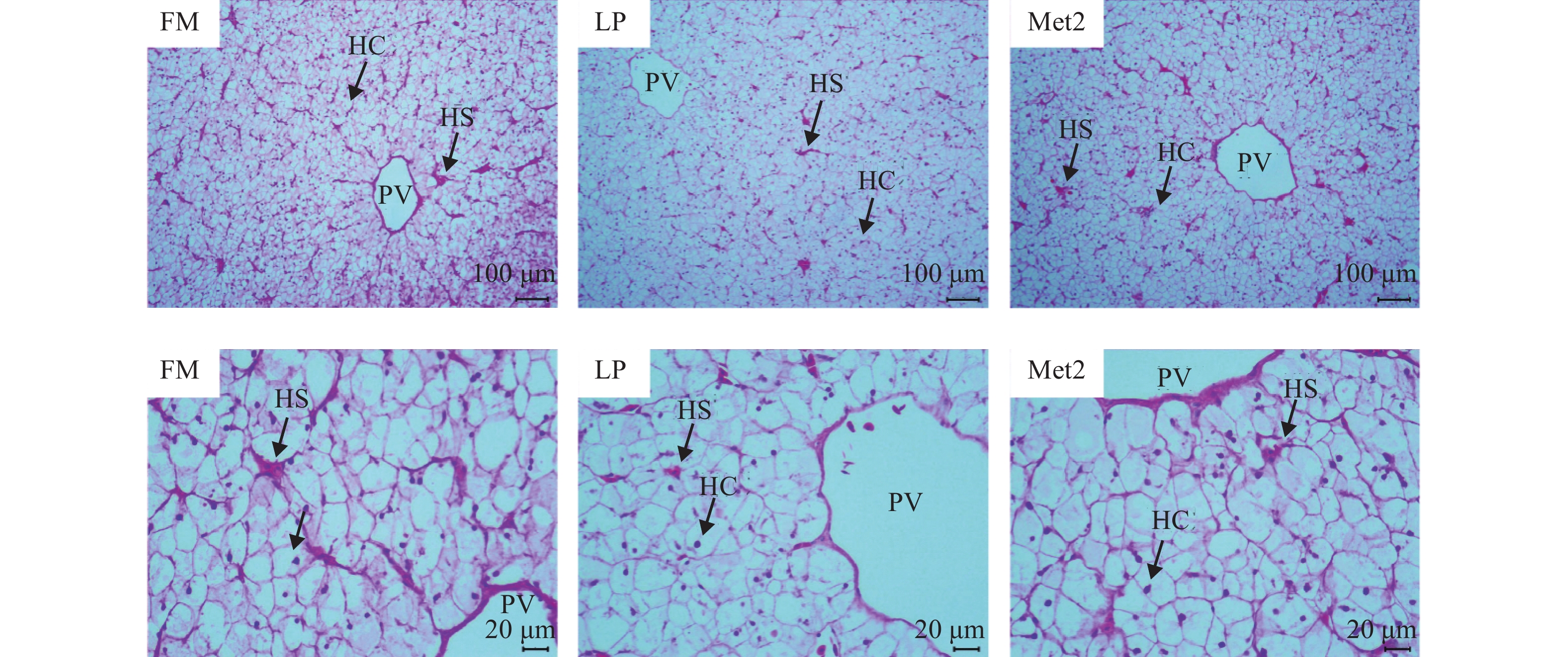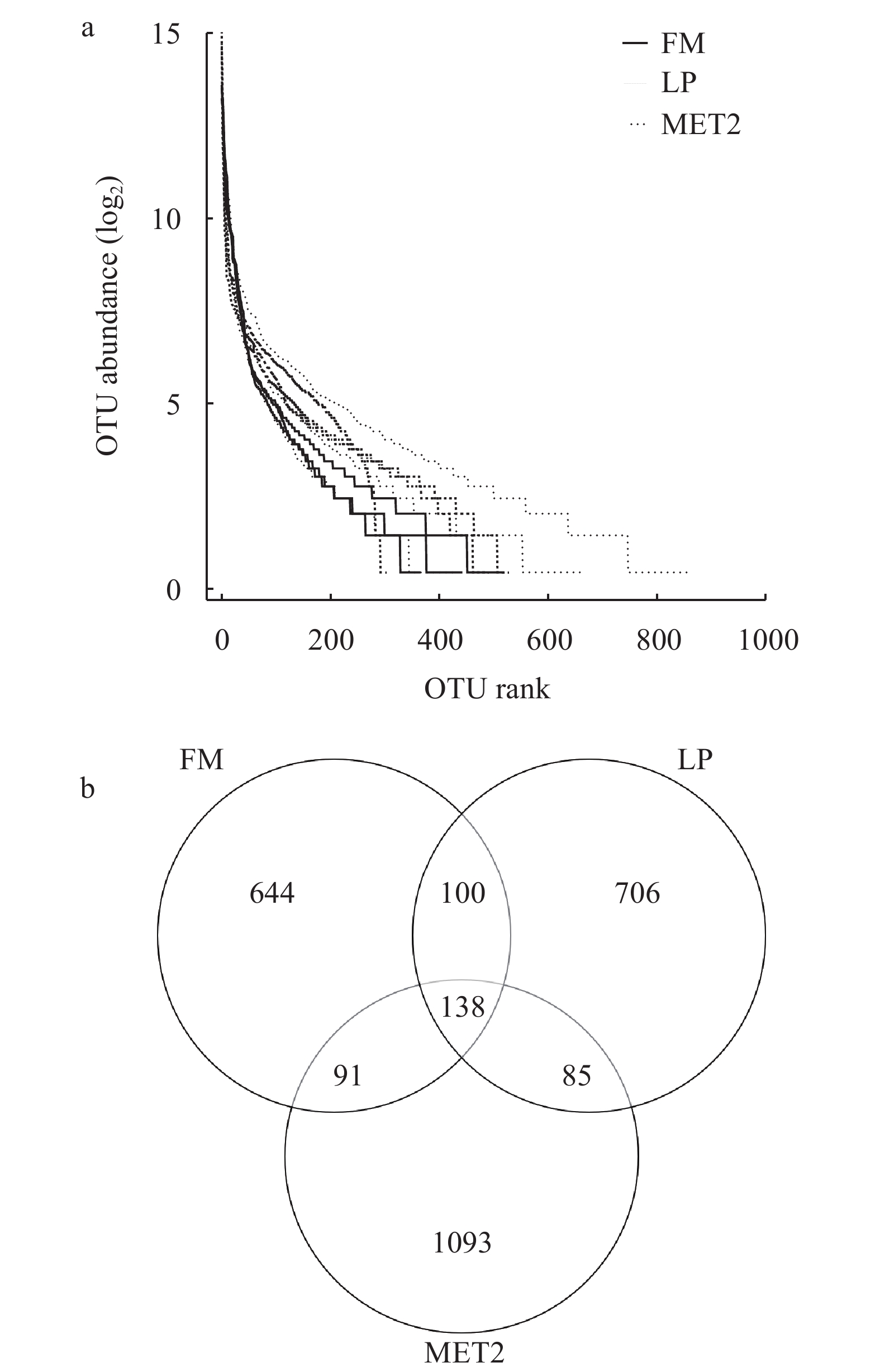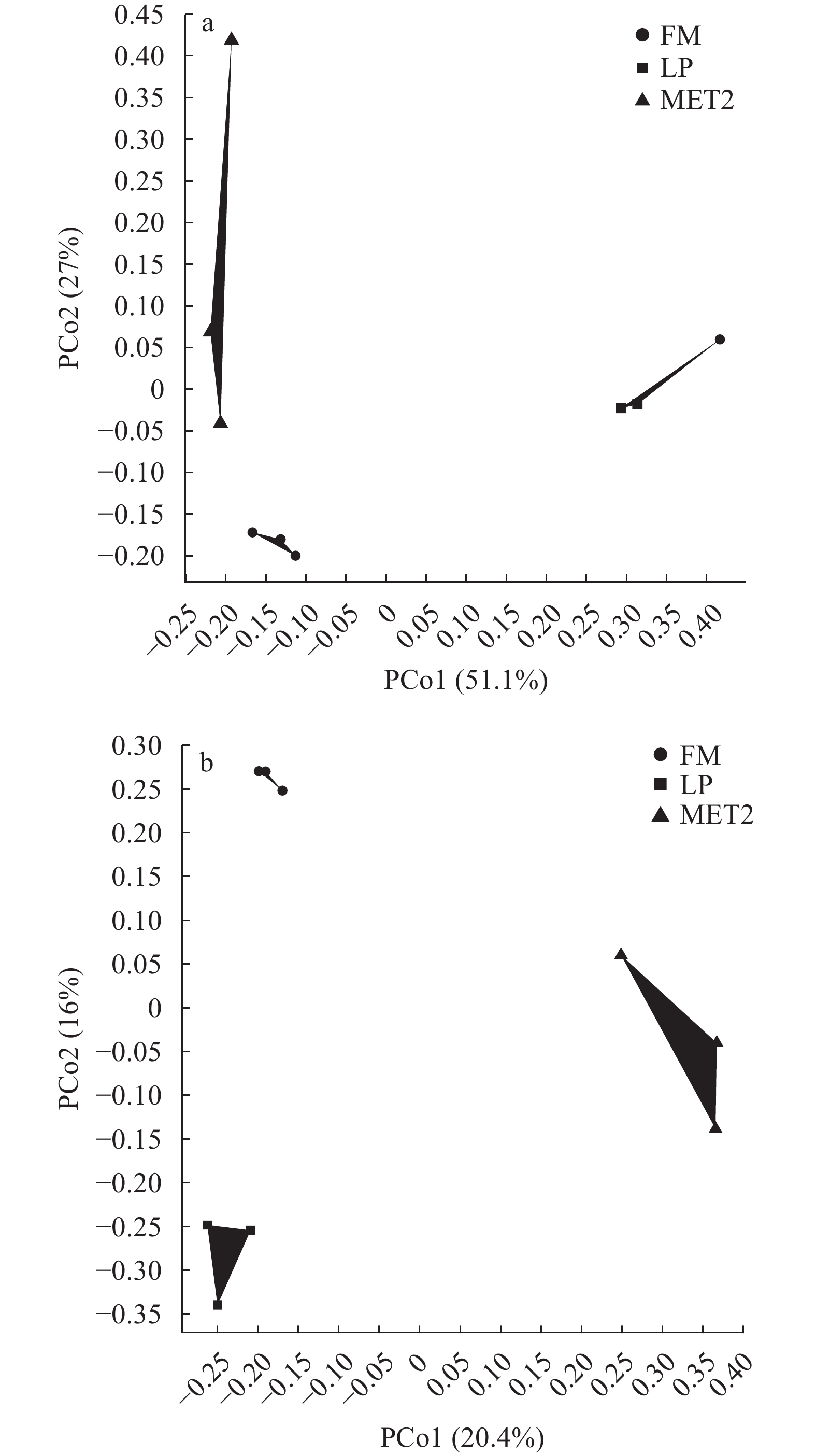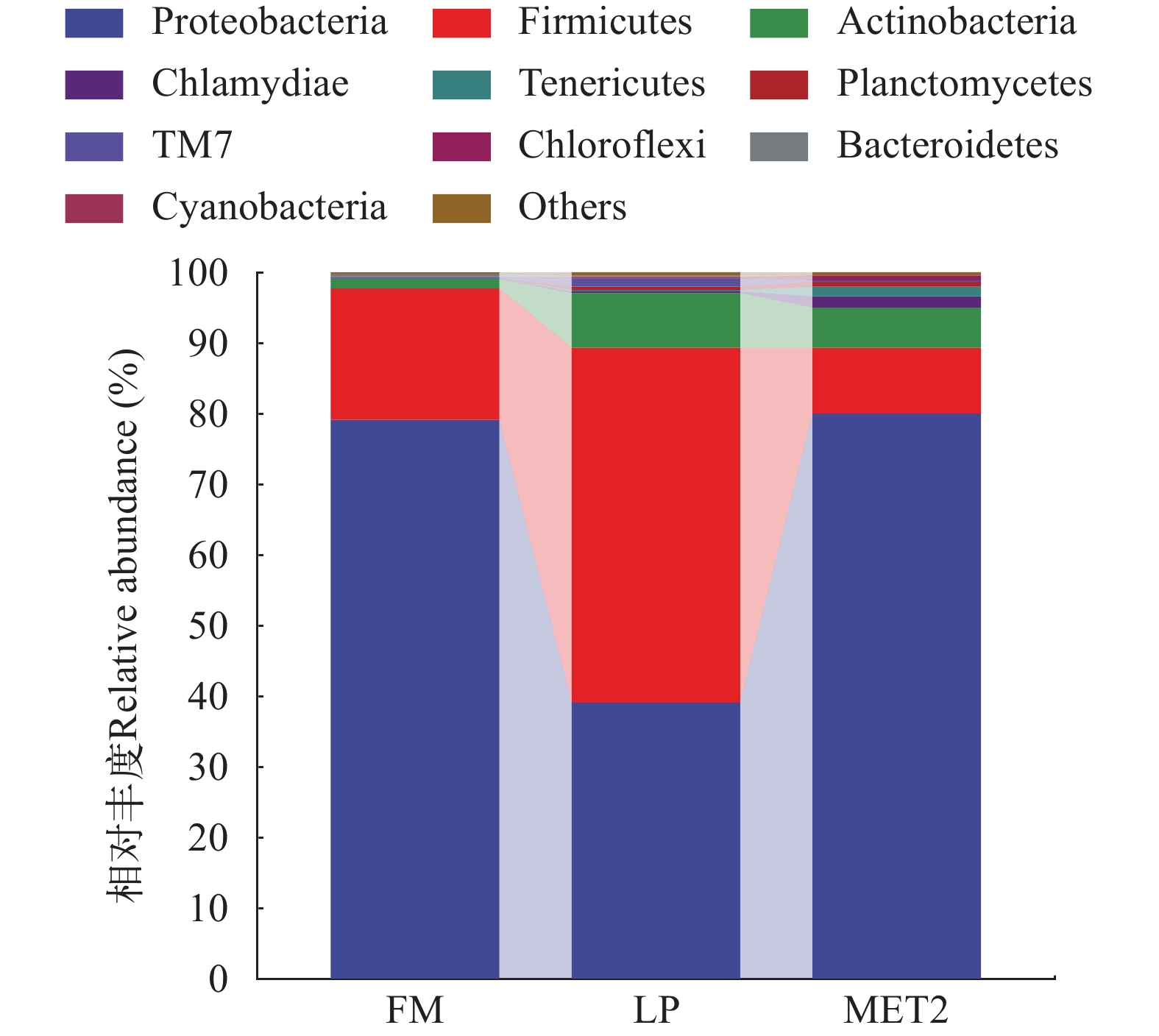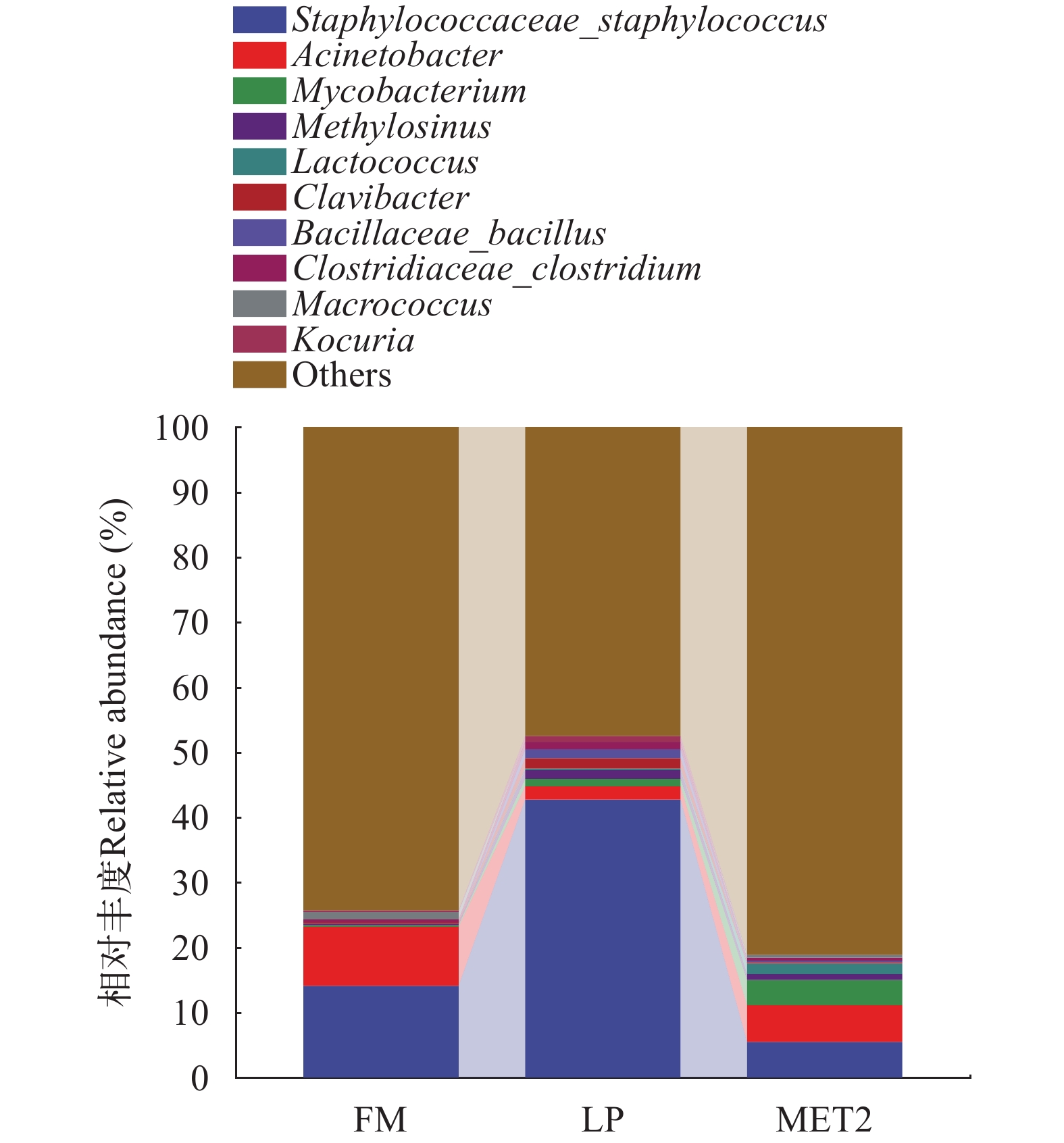ADDING METHIONINE TO PERFORMANCE ON THE GROWTH PERFORMANCE, LIVER HEALTH, AND INTESTINAL FLORA OF MONOPTERUS ALBUS PERFORMANCE
-
摘要:
为研究低蛋白饲料中添加蛋氨酸对黄鳝(Monopterus albus)生长性能、肝脏健康及肠道菌群的影响, 选取初始质量为(24.97±0.11) g的黄鳝为研究对象, 配制42% (FM组)和36% (LP组)两种蛋白水平的饲料, 并在LP组饲料基础上额外设置两个蛋氨酸剂量组: 0.25% (Met1)和0.50% (Met2)。实验共设置4个处理组, 每组3个重复, 养殖实验进行56d。结果表明: (1)相较于FM组, LP组黄鳝的增重率、鱼体粗蛋白和粗脂肪含量显著降低, 饵料系数显著升高。相较于LP组, 蛋氨酸添加组黄鳝的生长性能得到改善, 饵料系数显著降低; 且Met2组黄鳝肠道淀粉酶、脂肪酶和蛋白酶活性显著上升。(2)相较于FM组, LP组黄鳝血清中血氨、尿素氮、谷丙转氨酶、谷草转氨酶水平均显著上升。相较于LP组, Met2组黄鳝血清中各项指标水平均显著降低。(3)相较于FM组, LP组黄鳝肝脏过氧化氢酶、还原性谷胱甘肽与总抗氧化能力水平显著降低, 丙二醛含量显著增加, 并伴随着黄鳝肝脏结构受损; 相较于LP组, Met2组黄鳝肝脏抗氧化能力提升, 肝细胞形态完整, 空泡化比例降低。(4)相较于FM组, LP组在门水平上变形菌门相对丰度显著下降, 厚壁菌门与放线菌门相对丰度显著上升, 属水平上葡萄球菌属(Staphylococcus)、分枝杆菌属(Mycobacterium)、甲基孢囊菌属(Methylosinus)相对丰度显著上升, 不动杆菌属(Acinetobacter)相对丰度下降。相较于LP组, 蛋氨酸的添加降低了黄鳝肠道中部分有害菌的相对丰度, 另外Met2组具有最高的均匀度与丰富度。综上所述: 低蛋白饲料会降低黄鳝生长性能, 导致肝脏损伤和肠道菌群结构改变, 添加0.5%蛋氨酸可缓解肝脏损伤, 改善黄鳝生长性能和肝肠健康。
Abstract:This study was designed to investigate the effects of adding methionine to low-protein diet on the growth performance, liver health, and intestinal flora of Monopterus albus. A total of 600 eels weighing around 25.00 g were randomly assigned to four treatments with three replications each: FM (42% protein), LP (36% protein), Met1 (LP with 0.25% methionine), and Met2 (LP with 0.50% methionine) and fed for eight weeks. The results showed that: (1) Compared with the FM group, the weight gain rate, crude protein, and crude fat content of M. albus in the LP group decreased significantly (P<0.05), together with a significantly increased feed coefficient (P<0.05). However, dietary supplementation with 0.50% methionine improved the growth performance relative to the LP group, coupled with the increases in the intestinal amylase, lipase, and protease activities (P<0.05), as well as lowered the feed coefficient (P<0.05). (2) Compared with the FM group, the serum levels of blood ammonia, urea nitrogen, alanine aminotransferase, alkaline phosphatase, acid phosphatase, and aspartate aminotransferase increased significantly in the LP group (P<0.05), which were lower in the Met2 group (P<0.05). (3) Compared with the FM group, eel fed low-protein diets exhibited lower catalase, reduced glutathione, and total antioxidant capacity in the liver (P<0.05), while malondialdehyde content significantly increased (P<0.05), indicating oxidative stress and structural liver damage. In contrast, the Met2 group demonstrated improved liver antioxidant capacity, intact hepatocyte morphology, and reduced vacuolation ratio compared to the LP group. (4) The LP group exhibited a significant increase in the relative abundance of Staphylococcus, Mycobacterium, and Methylosinus, alongside a significant decrease in Acinetobacter compared to the FM group (P<0.05). In the Met2 group, the relative abundance of Staphylococcus and Methylocystis significantly decreased (P<0.05), while Mycobacterium significantly increased compared to the LP group (P<0.05). In summary, low-protein diet contributed to growth decline, liver damage, and intestinal microecological imbalance of M. albus. Supplementation with 0.5% methionine effectively maintained liver histomorphology, enhanced growth performance, and improved intestinal health of M. albus.
-
Keywords:
- Low-protein diet /
- Growth performance /
- Liver health /
- Intestinal flora /
- Monopterus albus
-
蛋白质是构建鱼体组织主要有机物(按干重计算约占65%—75%)[1], 也是组织更新和修复的主要原料。蛋白质能通过分解为机体供能, 还可通过参与酶、激素、抗体等特殊功能物质的合成对生命活动起到调控作用。鱼类获取蛋白质的主要方式是从外界摄入, 不同食性的鱼类对蛋白的需求也不尽相同, 乌鳢、加州鲈、日本鳗鲡等肉食性鱼类对饲料中蛋白需求在40%—50%[2]。在设计鱼类配方饲料时, 蛋白需求是被首先考虑的因素, 由于鱼粉和豆粕等主要饲料蛋白源依赖于进口, 供给不平衡导致水产饲料成本飙升。另外残饵中的大量氨氮进入水体后胁迫了水产动物的健康生长[3], 严重影响了水产行业的可持续发展。但如果只降低饲料蛋白含量又会对水产动物的生长速度和健康产生负面影响[4—6]。因此针对水产动物低蛋白饲料的营养改进策略势在必行。研究人员发现在饲料中添加必需氨基酸可以达到降低饲料中蛋白含量、促进水产动物生长和改善健康状况的目的[7]。在对布氏鲳鲹(Trachinotus blochii)的研究中发现蛋氨酸和赖氨酸可以提高鱼体的饲料利用率, 提升生长性能, 并减少鱼体对蛋白的需求[8]。刘梦梅[9]的研究表明在低蛋白饲料中加入蛋氨酸和赖氨酸不仅能显著提高草鱼(Ctenopharyngodon idella)的生长性能, 而且显著减少了氮的排泄。桂聪等[6]对大口黑鲈(Micropterus salmoides)研究发现, 降低5%的饲料蛋白后补充蛋氨酸和赖氨酸, 鱼体的抗氧化能力显著提升, 且低蛋白饲料造成的氧化损伤得到修复。因此在补充必需氨基酸可以减轻甚至消除低蛋白饲料对水产动物的生长和健康发育带来的负面影响。
蛋氨酸(Methionine)又称甲硫氨酸, 是一种非极性脂肪族含硫的必需氨基酸, 是多胺、肌酸、磷脂酰胆碱、谷胱甘肽、牛磺酸及乙酰辅酶A等多种物质的前体物质, 在机体内参与蛋白质合成、抗氧化、免疫应答等生理活动。在对大口黑鲈、凡纳滨对虾(Litopenaeus vannamei)、松浦镜鲤(Cyprinus carpio Songpu)、绿鳍马面鲀(Thamnaconus septentrionalis)、黄鳝(Monopterus albus)等水产动物的研究中表明蛋氨酸具有改善水产动物生长性能、饲料利用率, 提高消化酶活性, 抗氧化能力, 改善肠道微生物群落结构的功能[10—14]。黄鳝是属于硬骨纲、合鳃目、合鳃科、黄鳝属的一种肉食性鱼类, 因鱼体蛋白含量高且味道鲜美因而成为名贵水产动物。黄鳝对饲料中蛋白需求在40%以上[15], 饲料成本和环境压力严重影响了黄鳝养殖业的可持续发展。本实验选取黄鳝为实验对象, 通过在低蛋白饲料中添加蛋氨酸, 观察其对黄鳝的生长性能、肝脏健康及肠道菌群的影响, 为丰富肉食性鱼类在低蛋白饲料上的应用提供参考, 促进水产养殖业的可持续发展。
1. 材料与方法
1.1 实验设计与饲料制作
饲料成分及营养水平见表 1。本实验设计以鱼粉、豆粕和鸡肉粉为主要蛋白质来源, 鱼油和豆油为主要脂肪来源, 使用微晶纤维素配平, 根据实验室前期的研究[16], 设计两种蛋白水平的饲料, 分别为正常蛋白组(42%粗蛋白, FM组)和低蛋白组(35%粗蛋白, LP组), 根据实验室前期实验的研究[14], 在LP组的基础上设置两个蛋氨酸剂量组: (0.25%, Met1)和(0.5%, Met2)。饲料原料购于湖南省新瑞生物公司, DL-蛋氨酸(有效含量为99%)购于上海源叶生物科技有限公司, 制作饲料时将原料粉碎后通过80目筛网, 按成分含量由高到低逐步混合后, 加鱼油进入搅拌机充分搅拌至完全混合均匀, 混合完成后将饲料装袋在–20℃环境保存。
表 1 饲料成分及营养水平(%干物质)Table 1. Diet composition and nutritional level (% dry matter)原料Ingredient FM LP Met1 Met2 鱼粉Fish meal 42 36 36 36 豆粕Soybean meal 18 12 12 12 鸡肉粉Poultry by-product meal 5 5 5 5 啤酒酵母Brewer yeast 5 5 5 5 鱼油Fish oil 2 2.5 2.5 2.5 豆油Soybean oil 0 0.1 0.1 0.1 蛋氨酸Methioninea 0 0 0.25 0.5 微晶纤维素Cellulose 4.46 15.86 15.61 15.36 α淀粉α-starch 20 20 20 20 胆碱Choline chloride 0.5 0.5 0.5 0.5 磷酸二氢钙Ca(H2PO4)2 2 2 2 2 预混料Premixa 1 1 1 1 抗氧化剂Ethoxyquin 0.01 0.01 0.01 0.01 防霉剂Mould inhibitorb 0.03 0.03 0.03 0.03 总计Total 100 100 100 100 营养组成Proximate compositionc 粗蛋白质Crude protein 42.84 35.51 35.49 35.43 粗脂肪Crude lipid 6.53 6.45 6.49 6.47 灰分Ash 10.71 10.21 9.97 10.13 蛋氨酸Methionine 1.41 1.24 1.47 1.71 注: a预混料购于青岛玛斯特生物技术有限公司(山东青岛), 主要成分(mg/kg diet): KCl, 200 mg; KI (1%), 60 mg; CoCl2·6H2O (1%), 50 mg; CuSO4·5H2O, 30 mg; FeSO4· H2O, 400 mg; ZnSO4·H2O, 400 mg; MnSO4·H2O, 150 mg; Na2SeO3· 5H2O (1%), 65 mg; MgSO4·H2O, 2000 mg; 沸石粉 3645.85 mg; VB1, 12 mg; 核黄素 12 mg; VB6, 8 mg; VB12, 0.05 mg; VK3, 8 mg; 肌醇 100 mg; 泛酸 40 mg; 烟酸 50 mg; 叶酸 5 mg; 生物素 0.8 mg; VA, 25 mg; VCP1, 5 mg; VE, 50 mg; VC, 100 mg; 乙氧基喹啉 150 mg; 面粉 2434.15 mg; b防霉剂主要成分为丙酸钙; c饲料营养成分含量均为3次重复检测平均值Note: aPremix purchased in Qingdao Master Biotechnology Co., Ltd. (Qingdao, Shandong), the main ingredients (mg/kg diet): KCl, 200 mg; KI (1%), 60 mg; CoCl2·6H2O (1%), 50 mg; CuSO4·5H2O, 30 mg; FeSO4·H2O, 400 mg; ZnSO4·H2O, 400 mg; MnSO4·H2O, 150 mg; Na2SeO3·5H2O (1%), 65 mg; MgSO4·H2O, 2000 mg; Zeolite power, 3645.85 mg; VB1, 12 mg; Riboflavin, 12 mg; VB6, 8 mg; VB12, 0.05 mg; VK3, 8 mg; Inositol, 100 mg; Pantothenic acid, 40 mg; Niacin acid, 50 mg; Folic acid, 5 mg; Biotin, 0.8 mg; VA, 25 mg; VCP1, 5 mg; VE, 50 mg; VC, 100 mg; Ethoxyquin, 150 mg; Wheat meal, 2434.15 mg; bThe main component of mold inhibitor is calcium propionate; cNutrient content of feed is the average of 3 replicated tests 1.2 饲养管理
本实验在湖南省常德市西湖管理区黄鳝基地中进行。在实验开始15d前购买洞庭湖周边水域野生黄鳝苗种, 然后进行禁食暂养, 实验设置4个处理组, 每个处理组各设置3个重复网箱(2.0 m×1.5 m×1.5 m)。选取600尾形态规格相似的鳝苗(24.97±0.11) g随机均等分配到12个网箱中。稳定后使用冰蚯蚓和鱼浆混合物驯食, 训食阶段先使用冰蚯蚓和新鲜鱼浆混合物投喂, 视黄鳝的开口摄食情况逐步减少冰鲜饵料的比例, 同时由低到高的比例逐步加入配合饲料, 15d后开始停止投喂冰鲜饵料, 正式投喂配合饲料。投喂量为网箱内黄鳝总体重的3%—5%。养殖实验共持续56d。实验期间保持池塘养殖水体水温26.1—36.8℃, 溶解氧含量6.1—6.9 mg/L, 氨氮含量≤0.48 mg/L。
1.3 营养成分测定
使用干燥法(GB 5009.3-2016)烘干饲料和鱼体; 按照凯氏定氮法(GB 5009.5-2016)测量饲料和鱼体粗蛋白含量; 按照索氏提取法(GB 5009.6-2016)测定饲料和鱼体粗脂肪含量; 利用马弗炉(GB 5009.4-2016)测定粗灰分。按照(GB 5009.124-2016)测定饲料蛋氨酸含量。
1.4 生长形体指标
养殖实验结束后对黄鳝禁食, 24h后从每个网箱中随机取3尾黄鳝, 测量每条鱼的体长、体重, 解剖后测量其内脏重量, 用来计算增重率、存活率、脏体比、肥满度和饵料系数等指标。
存活率(Survival rate, SR, %)=100×Nt/NI;
增重率(Weight gain rate, WGR, %)=100×[Wt–WI]/WI;
饲料系数(Feed conversion ratio, FCR)=WD/[Wt–WI];
肝体比(Hepatosomatic index, HSI)=100×WL/Wt;
脏体比(Viscerosomatic index, VSI)=100×WV/Wt;
肥满度(Condition factor, CF, g/cm3)=100×Wt/L3。
式中, Nt为试验末黄鳝尾数(尾); NI为试验初黄鳝尾数(尾); Wt为末体重(g); WI为初体重(g); WD为饲料摄取量(g); WL为黄鳝肝脏重(g); WV为黄鳝内脏团重(g); L为黄鳝体长(cm)。
1.5 血清生化指标
在养殖实验结束后对黄鳝禁食, 24h后从每个网箱中随机取3尾, 抽尾端静脉血, 用于测量尿素氮(Blood urea nitrogen, BUN)、血氨(Blood ammonia, BA)、谷丙转氨酶(Alanine aminotransferase, ALT)、谷草转氨酶(Aspartate aminotransferase, AST)水平。
1.6 肠道生化指标
在养殖实验结束后对黄鳝禁食, 24h后从每个网箱中随机取3尾黄鳝, 解剖取肠, 测定肠道内淀粉酶(Amylase, AMS)、脂肪酶(Lipase, LPS)和胰蛋白酶(Trypsin, TRY)活性。
1.7 肝脏生化指标
在养殖实验结束后对黄鳝禁食, 24h后从每个网箱中随机取3尾黄鳝, 解剖取其肝组织, 后续用于测定总抗氧化能力(Total antioxidant capacity, T-AOC)、过氧化氢酶(Catalase, CAT)、谷胱甘肽(Glutathione, GSH)、谷胱甘肽-S 转移酶(Glutathione S-transferase, GST)、超氧化物歧化酶(Superoxide dismutase, SOD)、丙二醛(Malondialdehyde, MDA)。上述试剂盒均购买自南京建成生物工程研究所。
1.8 肝脏切片的制备
在禁食24h后,从FM、LP与Met2组的每个网箱随机挑选3尾黄鳝取其肝脏组织, 放入多聚甲醛溶液中固定24h后, 再经过脱水、透蜡、包埋、切片、染色等步骤制作成肝组织切片。
1.9 肠道菌群分析
在养殖结束后对FM、LP与Met2组黄鳝进行饱食投喂, 24h后从3个组中每个网箱随机选取6尾黄鳝解剖, 取其后肠的肠道内容物, 置于2 mL无酶管中, 放入–80℃冰箱中保存, 提取DNA步骤参见文献[17]。借助派森诺基因云(https://www.genescloud.cn)进行数据分析。
1.10 数据统计分析
使用Excel 2019进行数据的初步整理分析, 用SPSS27软件对数据进行单因素方差分析(ANOVA)。若差异显著(P<0.05), 采用Duncan’s进行多重检验, 用平均值±标准误(mean±SE)的形式表示结果。切片扫描后采用Slide Viewer图像分析软件观察分析。
2. 结果
2.1 低蛋白饲料中添加蛋氨酸对黄鳝生长性能及消化酶的影响
由表 2可知, 各组黄鳝在存活率、肝体比、脏体比、肥满度指标上无显著差异(P>0.05)。相较于FM组, LP组增重率显著下降, 饵料系数显著上升(P<0.05)。相较于LP组, Met1组和Met2组随着蛋氨酸添加量增高增重率呈显著上升的趋势(P<0.05), 同时饵料系数呈显著下降的趋势(P<0.05)。
表 2 低蛋白饲料中添加蛋氨酸对黄鳝生长性能的影响Table 2. Effects of methionine supplementation in low-protein diet on growth performance of M. albus指标
Index组别Group FM LP Met1 Met2 初均重
IBW (g)24.95±0.05 25.01±0.01 24.93±0.04 24.98±0.01 末均重
FBW (g)52.88±0.7d 44.71±0.3a 48.05±0.64b 49.90±0.39c 存活率
SR (%)92.67±2.91 92.67±1.33 95.33±2.91 92.00±3.06 增重率
WGR (%)111.97±2.89d 78.78±1.17a 92.76±2.39b 99.76±1.52c 饵料系数
FCR1.62±0.03a 2.28±0.03d 1.93±0.03c 1.76±0.01b 肝体比
HSI6.74±0.36 6.32±0.17 6.53±0.30 6.53±0.22 脏体比
VSI22.07±1.17 19.45±1.43 22.65±0.93 22.72±0.82 肥满度
CF (g/cm3)1.27±0.04 1.16±0.06 1.2±0.05 1.15±0.04 注: 数据为平均值±标准误, 同行数据的上标字母不同代表数据差异显著(P<0.05); 下同Note: Data are mean±SE, different superscript letters represent significant differences (P<0.05); the same applies below 由表 3可知, 各组间水分、灰分含量均无显著差异(P>0.05)。相较于FM组, LP与蛋氨酸添加组粗蛋白、粗脂肪含量均显著降低(P<0.05)。相较于LP组, 随着蛋氨酸添加量增高粗蛋白、粗脂肪含量呈显著上升的趋势(P<0.05)。而蛋氨酸组间无显著差异(P>0.05)。
表 3 低蛋白饲料中添加蛋氨酸对黄鳝全鱼体成分的影响(湿重)Table 3. Effects of methionine supplementation in low-protein diet on whole body composition of M. albus (wet weight)成分
Composition组别Group FM LP Met1 Met2 水分
Moisture (%)74.31±0.16 74.35±0.06 74.71±0.13 74.63±0.30 粗蛋白Crude
protein (%)15.78±0.23c 12.68±0.12a 13.63±0.09b 13.55±0.14b 粗脂肪
Crude lipid (%)3.42±0.05c 2.69±0.09a 3.07±0.05b 3.26±0.07b 灰分
Ash (%)3.15±0.05 3.16±0.12 3.13±0.05 3.10±0.10 由表 4可知, 相较于FM组, LP组黄鳝肠道淀粉酶、脂肪酶与胰蛋白酶活性下降, 其中淀粉酶与胰蛋白酶活性显著下降(P<0.05)。相较于LP组, 随着蛋氨酸添加量增高脂肪酶与胰蛋白酶活性呈上升趋势, 其中Met2组淀粉酶、脂肪酶与胰蛋白酶活性显著增加(P<0.05)。
表 4 低蛋白饲料中添加蛋氨酸对黄鳝肠道消化酶的影响Table 4. Effects of methionine supplementation in low-protein diet on intestinal digestive enzymes in M. albus消化酶
Digestive enzyme组别Group FM LP Met1 Met2 淀粉酶AMY
(U/mg prot)138.15±
1.84d113.88±
1.78b104.92±
2.06a127.42±
3.08c脂肪酶LPS
(U/g prot)197.07±
11.15a183.53±
6.08a214.1±
10.39ab238.21±
7.78c胰蛋白酶TRY
(U/mg prot)1486.26±
18.42c1307.99±
6.15a1342.93±
14.27a1390.57±
11.69b2.2 低蛋白饲料中添加蛋氨酸对黄鳝血清生化指标的影响
由表 5可知, 各组间黄鳝血清指标均有显著差异(P<0.05)。相较于FM组, LP组血清中BA、BUN、AST、ALT水平均显著升高(P<0.05); 相较于LP组, 蛋氨酸添加组血清中BA、BUN、AST与ALT水平显著下降。
表 5 低蛋白饲料中添加蛋氨酸对黄鳝血清生化指标的影响Table 5. Effects of methionine supplementation to low-protein diet on serum biochemical indexes of M. albus生化指标
Biochemical index组别Group FM LP Met1 Met2 血氨BA
(µmol/L)100.09±
3.65a140.18±
2.64c121.09±
3.18b128.36±
1.31b尿素氮BUN
(mmol/L)19.24±
0.72a31.33±
2.49c22.9±
1.49a24.1±
1.18a谷草转氨酶
AST (U/L)19.86±
0.41b27.36±
0.11c18.67±
0.68ab16.79±
1.01a谷丙转氨酶
ALT (U/L)11.09±
0.56a21.16±
0.27c13.33±
0.68b15.13±
0.98b2.3 低蛋白饲料中添加蛋氨酸对黄鳝肝脏抗氧化指标的影响
由表 6可知,相较于FM组, LP组黄鳝肝脏中CAT、GSH与T-AOC水平显著下降(P<0.05), MDA含量显著上升(P<0.05)。而相较于LP组, 蛋氨酸添加组黄鳝肝脏CAT、GSH、SOD、T-AOC水平均升高, 而GST与MDA水平降低, 其中Met2组上述指标差异显著(P<0.05); 而Met1组在GST、GSH、T-AOC水平上差异不显著(P>0.05)。
表 6 低蛋白饲料中添加蛋氨酸对黄鳝肝脏抗氧化指标的影响Table 6. Effects of methionine supplementation to low-protein feed on liver biochemical indexes of M. albus指标
Index组别Group FM LP Met1 Met2 过氧化氢酶CAT
(U/mg prot)28.87±
0.98c18.24±
0.42a22.55±
1.49b23.92±
1.32b谷胱甘肽S-转移酶
GST (U/mg prot)42.30±
2.95c55.16±
1.53bc50.66±
1.02ab46.11±
1.79a还原性谷胱甘肽
GSH (μmol/g prot)13.98±
0.74c9.34±
0.05a10.85±
1.02ab12.70±
0.52bc超氧化物歧化酶
SOD (U/mg prot)14.35±
0.48ab12.09±
1.15a16.99±
0.39b15.54±
0.8b总抗氧化能力
T-AOC (mmol/g)0.73±
0.01c0.59±
0.03ab0.64±
0.01b0.56±
0.02a丙二醛MDA
(nmol/mg prot)0.67±
0.01a1.29±
0.06d1.12±
0.08c0.85±
0.04b2.4 低蛋白饲料中添加蛋氨酸对黄鳝肝脏组织学结构的影响
由图 1可知, 与FM组相比, 降低饲料蛋白水平使LP组黄鳝肝脏单位面积内肝细胞的细胞核数量较少, 细胞空泡化比例增加, 肝血窦不明显。Met2组相较于LP组, 黄鳝肝细胞形态完整, 边缘清晰, 空泡化比例降低。
2.5 低蛋白饲料中添加蛋氨酸对黄鳝肠道菌群的影响
由图 2和图 3可知, 各组间黄鳝肠道菌群组成之间具有明显的差异。Met2组黄鳝肠道菌群分类单元数目最高, FM组与LP组分类单元数目依次降低, 同时各组特有单元数依次为1093、706和644, 其中3组共有单元数为138。相较于FM组与LP组, Met2组黄鳝肠道菌群有最高的物种丰度, 且物种分布均匀度较高。
由图 4可知, 门水平的主要种群为变形菌门(Proteobacteria)、厚壁菌门(Firmicutes)、放线菌门(Actinobacteria)和衣原体门(Chlamydiae)等。相较于FM组, LP组肠道变形菌门相对丰度显著下降, 厚壁菌门与放线菌门相对丰度显著上升(P<0.05), 而衣原体门间无显著差异(P>0.05)。相较于LP组, Met2组厚壁菌门、放线菌门相对丰度显著下降, 变形菌门与衣原体门显著上升(P<0.05; 表 7)。
表 7 门水平上肠道菌群排名前四的菌群物种相对丰度Table 7. Relative abundance of the top four species of intestinal flora at the phylum level (%)门Phylum 组别Group FM LP Met2 变形菌门Proteobacteria 79.15±0.99b 39.39±2.77a 80.43±1.85b 厚壁菌门Firmicutes 18.60±0.81b 49.87±0.52c 9.16±0.54a 放线菌门Actinobacteria 1.24±0.08a 7.82±0.24c 3.42±0.19b 衣原体门Chlamydiae 0.03±0.01a 0.18±0.02a 1.56±0.19b 由图 5可知, 葡萄球菌属(Staphylococcus)、不动杆菌属(Acinetobacter)、分枝杆菌属(Mycobacterium)、甲基孢囊菌属(Methylosinus)为属水平主要类群。由表 8可知, 相较于FM组, LP组肠道葡萄球菌属、分枝杆菌属、甲基孢囊菌属相对丰度显著上升(P<0.05), 而不动杆菌属相对丰度下降(P<0.05)。相较于LP组, Met2组肠道葡萄球菌与甲基孢囊菌属相对丰度显著下降(P<0.05), 而分枝杆菌属相对丰度显著上升(P<0.05)。
表 8 属水平上肠道菌群排名前四的菌群物种相对丰度Table 8. Relative abundance of the top four species of intestinal flora at the genus level (%)属Genus 组别Group FM LP Met2 葡萄球菌属Staphylococcus 14.14±0.61b 42.41±1.25c 5.39±1.22a 不动杆菌属Acinetobacter 9.13±0.25b 2.05±0.24a 5.80±2.40ab 分枝杆菌属Mycobacterium 0.14±0.02a 1.08±0.08b 3.76±0.30c 甲基孢囊菌属Methylosinus 0.17±0.02a 1.33±0.04c 0.86±0.09b 3. 讨论
3.1 低蛋白饲料中添加蛋氨酸对黄鳝生长性能的影响
增重率和饵料系数是评估养殖效益的重要指标。在本研究中低蛋白组黄鳝饲料产生了生长性能下降、饵料系数升高和鱼体蛋白沉积减少等现象。在对草鱼[4, 5]和大口黑鲈[6]的研究也发现降低饲料蛋白水平不利于鱼类的生长。由于鱼类在生命活动中会不断对蛋白质进行代谢, 为机体提供能量并为各种代谢提供底物, 因此当鱼体从饲料中摄入的蛋白无法满足机体需求时, 鱼体生长会减缓或停止。结合低蛋白组消化酶活性显著低于正常鱼粉组, 猜测是鱼体摄入蛋白不足导致组织中的蛋白质也被消耗用来维持必要的生命活动[1]。机体合成消化酶的底物减少, 对蛋白和脂肪等营养物质的消化吸收能力减弱, 进一步导致饵料系数升高和生长性能降低[18]。蛋氨酸添加组的黄鳝体成分中粗蛋白沉积显著提升, 消化酶活性显著升高, 与建鲤(Cyprinus carpio var. Jian) [19]和军曹鱼[20]的研究相类似。研究表明蛋氨酸被认为是真核细胞合成蛋白的起始氨基酸, 缺少蛋氨酸使蛋白质翻译过程不能正确进行[21]。蛋氨酸代谢产物S-腺苷甲硫胺酸(S-adenosyl-L-methionine, SAM)可作为甲基供体参与蛋白质甲基化过程[22], 在蛋白质翻译后修饰过程中发挥重要作用, 使蛋白质的结构和功能多样化[23]。蛋氨酸转硫途径的中间产物半胱氨酸(Cysteine, Cys)具有形成二硫键的功能, 在蛋白质折叠过程中发挥重要作用[24]。本实验中表现在促进了消化酶等功能蛋白的合成及发挥作用。机体消化吸收的营养物质增多改善了鱼体的生长性能。SAM还参与了胆碱、乙酰胆碱、磷脂酰胆碱、肉碱等多种物质的合成, 为合成脂蛋白和胆固醇提供乙酰辅酶A, 有助于机体对营养物质的吸收和转运, 为机体的构成和新陈代谢过程提供物质基础[22, 25]。在体成分中的粗蛋白和粗脂肪沉积显著增加。
3.2 低蛋白饲料中添加蛋氨酸对黄鳝血清生化的影响
血清是鱼类用来运送营养物质和代谢废物的重要工具, 因此血清生化指标被认为是评估鱼类健康状态的重要工具。机体对蛋白质的需求实际上是对氨基酸的代谢需求, 氨基酸在体内代谢后一部分以营养物质的形式在机体内沉积下来, 另一部分代谢后以氨的形式排出体外。转氨酶为氨基在酮酸与氨基酸之间转化提供条件[26], 主要的工作场所是肝脏, 当肝细胞受损后转氨酶会逃逸到血清中, 因此血清中的转氨酶活性可以作为评价肝脏损伤程度的指标[27]。本研究中低蛋白组转氨酶活性较高, 在添加蛋氨酸后活性下降, 表明添加蛋氨酸可以修复低蛋白饲料对肝脏健康产生的负面影响。与桂聪等[6]对大口黑鲈的研究结果类似。尿素氮反映了体内氨基酸的代谢平衡, 指标升高说明更多的蛋白质参与到分解供能的过程中[28, 29]。血氨的代谢场所是肝脏, 通过鸟氨酸循环生成尿素排出机体, 或者转化为无毒的中间产物谷氨酰胺, 最后被还原为氨排出体外[28, 30]。本实验中低蛋白组尿素氮含量较高说明鱼体摄入蛋白不足的条件下, 蛋白质更多用于机体代谢以维持生命活动[1]; 血氨含量较高表明肝脏代谢氨的过程受阻, 也从侧面证实了黄鳝肝脏结构受损, 肝脏功能不能正常运行。添加蛋氨酸后血氨、尿素氮含量均下降, 类似的现象也出现在对松浦银鲫[31]的研究中。这推测是蛋氨酸进入机体后调控了功能性蛋白质合成[21—24], 营养物质的转运效率增加[22]; 肝脏损伤得到缓解和修复, 血氨和尿素氮的含量随之降低。
3.3 低蛋白饲料中添加蛋氨酸对黄鳝肝脏抗氧化的影响
研究表明鱼类的肝脏不仅通过分泌胆汁参与机体对营养物质的消化吸收, 还是抗氧化系统的重要载体[32]。机体在进行新陈代谢过程中会伴随着大量氧自由基产生, 它可在机体内产生脂质过氧化、破坏蛋白结构、损伤DNA、RNA, 严重可引起组织和器官功能丧失等负面影响[33]。相应的机体内也存在抗氧化系统保护机体免受氧化损伤, 抗氧化能力的高低可反映出机体健康程度[34]。丙二醛是机体内自由基与细胞中不饱和脂肪酸过氧化反应后的产物, 可反映出机体受到过氧化的程度[35]。本实验中丙二醛含量在低蛋白组含量上升, 在蛋氨酸添加组显著下降。为更直观观察肝脏氧化受损情况, 综合血清中谷草转氨酶活性和肝脏中丙二醛含量分析, Met2组比Met1组对LP组有显著的变化, 因此选取FM组、LP组和Met2组制作肠道HE切片, 肝脏组织结构显示低蛋白组黄鳝肝细胞发生空泡化, Met2组细胞空泡化比例降低, 肝细胞形态相对完整。综合而言, 蛋氨酸缓解了低蛋白引起的肝脏损伤。在对大口黑鲈的研究中也有此类发现[6, 10]。抗氧化系统受到抗氧化酶和非酶类分子的共同调控, 氧自由基可被SOD转化为H2O2, 再通过CAT转化为H2O[36]。GSH被认为是氧化还原过程中的主要非蛋白低分子量调节剂, 通常作为底物结合GST共同参与对机体内氧化物质的清除[37]。T-AOC用来衡量机体内抗氧化酶和非酶类抗氧化剂的总抗氧化能力。当氧化应激发生时, 抗氧化酶活性也随之提升[33]。本研究中低蛋白组抗氧化酶活性较低, 杨贺舒等[38]在对杂交黄颡鱼(Pelteobagrus fulvidraco ♀×Pelteobagrus vachelli ♂)的研究中也发现降低饲料5%蛋白水平后, T-AOC和CAT活性都降低。本研究添加蛋氨酸后抗氧化酶活性提升, 在对松浦镜鲤和建鲤的研究中都发现添加蛋氨酸可对SOD和CAT活性产生显著提升[12, 39]。研究表明蛋氨酸不仅可以作为蛋白质合成的底物, 促进抗氧化酶等功能性蛋白的合成, 而且其转硫代谢的产物Cys既是生成GSH的前体物质[22, 37], 还是产生机体内源性气体H2S的主要底物[40]。H2S可作为气态信号分子在机体广泛存在[41], 可通过上调胱氨酸(Cystine)转运效率促进GSH的生成[42], 提高了机体内GSH含量以应对机体内的氧化反应。在对建鲤的研究中也发现随着蛋氨酸添加, GSH含量显著增加[39]。另外Cys也可以转化为牛磺酸, 牛磺酸在增强机体免疫力及缓解氧化损伤的能力发挥显著作用[43]。有研究将蛋氨酸与磷酸戊糖途径联系起来, 磷酸戊糖途径是抗氧化代谢的重要途径, 补充蛋氨酸后加速磷酸戊糖途径的氧化分支代谢, 提高抗氧化能力[44]。
3.4 低蛋白饲料中添加蛋氨酸对黄鳝肠道菌群组成的影响
肠道菌群参与机体的新陈代谢和营养免疫等生理活动, 被认为是隐藏的“代谢器官”[45]。菌群的组成结构与鱼类的生长性能与消化吸收能力密切相关[46]。综合对生长和消化酶活性结果的分析, 发现Met2组较Met1组对LP组有更好的生长性能和更高的消化酶活性, 因此选取FM、LP与Met2组黄鳝进行肠道菌群分析。结果显示, 本研究中各处理组间黄鳝肠道菌群的共有物种较少, 组间分类组成差异较大, Met2组的黄鳝肠道菌群的均匀度和丰富度都是各组间最高, 在对大口黑鲈肠道的研究中也发现蛋氨酸可以提高肠道菌群的均匀度与丰富度[10], 与本研究结果相似。肠道菌群的丰度与组成易受到饲料等外界因素的影响[45—47], 在本研究中可能是蛋白水平的变化使肠道菌群可利用的营养成分组成发生改变, 从而促使菌群组成结构发生变化。从门水平来看, 变形菌门、厚壁菌门、放线菌门丰度约占90%以上, 与前人研究相符[48]。变形菌门是鱼类肠道常见菌门, 门下一些菌与宿主消化功能具有较高的相关性[48, 49], 可以通过产生多羟基丁酸盐作为肠道上皮细胞的能量来源, 对维持肠道健康和改善鱼类的生长具有重要作用[50, 51], 本研究中蛋氨酸添加组提高变形菌门丰度的结果与大口黑鲈的研究结果相符[10]。低蛋白组饲料黄鳝肠道厚壁菌门丰度显著升高, 推测是厚壁菌门下菌种可增强肠道对植源型蛋白的吸收效率[52], 低蛋白条件的肠道对其需求较高。蛋氨酸添加后降低了肠道中厚壁菌门的相对丰度, 可能是因为肠道消化酶活性上升后, 肠道对厚壁菌门的生态需求降低导致相对丰度下调[46, 52]。放线菌门可以通过在肠道定植产生生物碱、内酯环肽化合物等物质增强宿主对病原入侵的防御能力[10], 本研究中蛋氨酸的添加使放线菌门丰度达到正常鱼粉组水平。从属水平来分析, 葡萄球菌属下菌种多为生物病原体[53], 其存在易增加宿主感染风险, 还可能是导致肝脏发生损伤的潜在因素[54]。蛋氨酸添加组降低其丰度的结果与在条纹鲇(Pangasius hypophthalmus)上的研究相类似[54]。不动杆菌属下菌种为需氧性革兰氏阴性菌, 多发现于有出血症与含有结肠腔疾病的鱼体肠道中[55]。分枝杆菌属虽是潜在的致病因子[56], 但也有研究表明其依托固醇类物质生长, 参与到宿主的代谢中[57]。综合来看, 蛋氨酸的添加促使黄鳝肠道对营养物质的吸收能力提高, 可能使肠道内营养物质组成改变, 符合生态需求的菌种增多, 表现为部分有害菌丰度降低, 有利于维持肠道健康。
4. 结论
低蛋白饲料可造成黄鳝的肝脏损伤和肠道菌群结构发生改变, 降低了黄鳝生长性能; 在低蛋白饲料中添加蛋氨酸后减轻了肝脏损伤, 增强了肝脏抗氧化能力, 改善了黄鳝的生长性能和肠道菌群结构。
众多研究表明, 在低蛋白饲料中添加一定比例的脂质, 水产动物机体中的蛋白质将更多用于构成机体组织, 而非被分解消耗获得能量, 即存在脂肪对蛋白的节约效应。未来将在此研究的基础上设计低蛋白高脂饲料配方, 为研发优化黄鳝的配方饲料提供理论指导。
-
表 1 饲料成分及营养水平(%干物质)
Table 1 Diet composition and nutritional level (% dry matter)
原料Ingredient FM LP Met1 Met2 鱼粉Fish meal 42 36 36 36 豆粕Soybean meal 18 12 12 12 鸡肉粉Poultry by-product meal 5 5 5 5 啤酒酵母Brewer yeast 5 5 5 5 鱼油Fish oil 2 2.5 2.5 2.5 豆油Soybean oil 0 0.1 0.1 0.1 蛋氨酸Methioninea 0 0 0.25 0.5 微晶纤维素Cellulose 4.46 15.86 15.61 15.36 α淀粉α-starch 20 20 20 20 胆碱Choline chloride 0.5 0.5 0.5 0.5 磷酸二氢钙Ca(H2PO4)2 2 2 2 2 预混料Premixa 1 1 1 1 抗氧化剂Ethoxyquin 0.01 0.01 0.01 0.01 防霉剂Mould inhibitorb 0.03 0.03 0.03 0.03 总计Total 100 100 100 100 营养组成Proximate compositionc 粗蛋白质Crude protein 42.84 35.51 35.49 35.43 粗脂肪Crude lipid 6.53 6.45 6.49 6.47 灰分Ash 10.71 10.21 9.97 10.13 蛋氨酸Methionine 1.41 1.24 1.47 1.71 注: a预混料购于青岛玛斯特生物技术有限公司(山东青岛), 主要成分(mg/kg diet): KCl, 200 mg; KI (1%), 60 mg; CoCl2·6H2O (1%), 50 mg; CuSO4·5H2O, 30 mg; FeSO4· H2O, 400 mg; ZnSO4·H2O, 400 mg; MnSO4·H2O, 150 mg; Na2SeO3· 5H2O (1%), 65 mg; MgSO4·H2O, 2000 mg; 沸石粉 3645.85 mg; VB1, 12 mg; 核黄素 12 mg; VB6, 8 mg; VB12, 0.05 mg; VK3, 8 mg; 肌醇 100 mg; 泛酸 40 mg; 烟酸 50 mg; 叶酸 5 mg; 生物素 0.8 mg; VA, 25 mg; VCP1, 5 mg; VE, 50 mg; VC, 100 mg; 乙氧基喹啉 150 mg; 面粉 2434.15 mg; b防霉剂主要成分为丙酸钙; c饲料营养成分含量均为3次重复检测平均值Note: aPremix purchased in Qingdao Master Biotechnology Co., Ltd. (Qingdao, Shandong), the main ingredients (mg/kg diet): KCl, 200 mg; KI (1%), 60 mg; CoCl2·6H2O (1%), 50 mg; CuSO4·5H2O, 30 mg; FeSO4·H2O, 400 mg; ZnSO4·H2O, 400 mg; MnSO4·H2O, 150 mg; Na2SeO3·5H2O (1%), 65 mg; MgSO4·H2O, 2000 mg; Zeolite power, 3645.85 mg; VB1, 12 mg; Riboflavin, 12 mg; VB6, 8 mg; VB12, 0.05 mg; VK3, 8 mg; Inositol, 100 mg; Pantothenic acid, 40 mg; Niacin acid, 50 mg; Folic acid, 5 mg; Biotin, 0.8 mg; VA, 25 mg; VCP1, 5 mg; VE, 50 mg; VC, 100 mg; Ethoxyquin, 150 mg; Wheat meal, 2434.15 mg; bThe main component of mold inhibitor is calcium propionate; cNutrient content of feed is the average of 3 replicated tests 表 2 低蛋白饲料中添加蛋氨酸对黄鳝生长性能的影响
Table 2 Effects of methionine supplementation in low-protein diet on growth performance of M. albus
指标
Index组别Group FM LP Met1 Met2 初均重
IBW (g)24.95±0.05 25.01±0.01 24.93±0.04 24.98±0.01 末均重
FBW (g)52.88±0.7d 44.71±0.3a 48.05±0.64b 49.90±0.39c 存活率
SR (%)92.67±2.91 92.67±1.33 95.33±2.91 92.00±3.06 增重率
WGR (%)111.97±2.89d 78.78±1.17a 92.76±2.39b 99.76±1.52c 饵料系数
FCR1.62±0.03a 2.28±0.03d 1.93±0.03c 1.76±0.01b 肝体比
HSI6.74±0.36 6.32±0.17 6.53±0.30 6.53±0.22 脏体比
VSI22.07±1.17 19.45±1.43 22.65±0.93 22.72±0.82 肥满度
CF (g/cm3)1.27±0.04 1.16±0.06 1.2±0.05 1.15±0.04 注: 数据为平均值±标准误, 同行数据的上标字母不同代表数据差异显著(P<0.05); 下同Note: Data are mean±SE, different superscript letters represent significant differences (P<0.05); the same applies below 表 3 低蛋白饲料中添加蛋氨酸对黄鳝全鱼体成分的影响(湿重)
Table 3 Effects of methionine supplementation in low-protein diet on whole body composition of M. albus (wet weight)
成分
Composition组别Group FM LP Met1 Met2 水分
Moisture (%)74.31±0.16 74.35±0.06 74.71±0.13 74.63±0.30 粗蛋白Crude
protein (%)15.78±0.23c 12.68±0.12a 13.63±0.09b 13.55±0.14b 粗脂肪
Crude lipid (%)3.42±0.05c 2.69±0.09a 3.07±0.05b 3.26±0.07b 灰分
Ash (%)3.15±0.05 3.16±0.12 3.13±0.05 3.10±0.10 表 4 低蛋白饲料中添加蛋氨酸对黄鳝肠道消化酶的影响
Table 4 Effects of methionine supplementation in low-protein diet on intestinal digestive enzymes in M. albus
消化酶
Digestive enzyme组别Group FM LP Met1 Met2 淀粉酶AMY
(U/mg prot)138.15±
1.84d113.88±
1.78b104.92±
2.06a127.42±
3.08c脂肪酶LPS
(U/g prot)197.07±
11.15a183.53±
6.08a214.1±
10.39ab238.21±
7.78c胰蛋白酶TRY
(U/mg prot)1486.26±
18.42c1307.99±
6.15a1342.93±
14.27a1390.57±
11.69b表 5 低蛋白饲料中添加蛋氨酸对黄鳝血清生化指标的影响
Table 5 Effects of methionine supplementation to low-protein diet on serum biochemical indexes of M. albus
生化指标
Biochemical index组别Group FM LP Met1 Met2 血氨BA
(µmol/L)100.09±
3.65a140.18±
2.64c121.09±
3.18b128.36±
1.31b尿素氮BUN
(mmol/L)19.24±
0.72a31.33±
2.49c22.9±
1.49a24.1±
1.18a谷草转氨酶
AST (U/L)19.86±
0.41b27.36±
0.11c18.67±
0.68ab16.79±
1.01a谷丙转氨酶
ALT (U/L)11.09±
0.56a21.16±
0.27c13.33±
0.68b15.13±
0.98b表 6 低蛋白饲料中添加蛋氨酸对黄鳝肝脏抗氧化指标的影响
Table 6 Effects of methionine supplementation to low-protein feed on liver biochemical indexes of M. albus
指标
Index组别Group FM LP Met1 Met2 过氧化氢酶CAT
(U/mg prot)28.87±
0.98c18.24±
0.42a22.55±
1.49b23.92±
1.32b谷胱甘肽S-转移酶
GST (U/mg prot)42.30±
2.95c55.16±
1.53bc50.66±
1.02ab46.11±
1.79a还原性谷胱甘肽
GSH (μmol/g prot)13.98±
0.74c9.34±
0.05a10.85±
1.02ab12.70±
0.52bc超氧化物歧化酶
SOD (U/mg prot)14.35±
0.48ab12.09±
1.15a16.99±
0.39b15.54±
0.8b总抗氧化能力
T-AOC (mmol/g)0.73±
0.01c0.59±
0.03ab0.64±
0.01b0.56±
0.02a丙二醛MDA
(nmol/mg prot)0.67±
0.01a1.29±
0.06d1.12±
0.08c0.85±
0.04b表 7 门水平上肠道菌群排名前四的菌群物种相对丰度
Table 7 Relative abundance of the top four species of intestinal flora at the phylum level (%)
门Phylum 组别Group FM LP Met2 变形菌门Proteobacteria 79.15±0.99b 39.39±2.77a 80.43±1.85b 厚壁菌门Firmicutes 18.60±0.81b 49.87±0.52c 9.16±0.54a 放线菌门Actinobacteria 1.24±0.08a 7.82±0.24c 3.42±0.19b 衣原体门Chlamydiae 0.03±0.01a 0.18±0.02a 1.56±0.19b 表 8 属水平上肠道菌群排名前四的菌群物种相对丰度
Table 8 Relative abundance of the top four species of intestinal flora at the genus level (%)
属Genus 组别Group FM LP Met2 葡萄球菌属Staphylococcus 14.14±0.61b 42.41±1.25c 5.39±1.22a 不动杆菌属Acinetobacter 9.13±0.25b 2.05±0.24a 5.80±2.40ab 分枝杆菌属Mycobacterium 0.14±0.02a 1.08±0.08b 3.76±0.30c 甲基孢囊菌属Methylosinus 0.17±0.02a 1.33±0.04c 0.86±0.09b -
[1] Wilson R P. Amino Acids and Proteins [M]. Fish Nutrition. Amsterdam: Elsevier, 2003: 143-179.
[2] 钱雪桥, 崔奕波, 解绶启, 等. 养殖鱼类饲料蛋白需要量的研究进展 [J]. 水生生物学报, 2002, 26(4): 410-416.] doi: 10.3724/issn1000-3207-2002-4-410-k Qian X Q, Cui Y B, Xie S Q, et al. A review on dietary protein requirement for aquaculture fishes [J]. Acta Hydrobiologica Sinica, 2002, 26(4): 410-416. [ doi: 10.3724/issn1000-3207-2002-4-410-k
[3] Yadata G W, Ji K, Liang H, et al. Effects of dietary protein levels with various stocking density on growth performance, whole body composition, plasma parameters, nitrogen emission and gene expression related to TOR signaling of juvenile blunt snout bream (Megalobrama ambylcephala) [J]. Aquaculture, 2020(519): 734730. doi: 10.1016/j.aquaculture.2019.734730
[4] Yu H, Liang H, Ren M, et al. A study to explore the effects of low dietary protein levels on the growth performance and nutritional metabolism of grass carp (Ctenopharyngodon idella) fry [J]. Aquaculture, 2022(546): 737324. doi: 10.1016/j.aquaculture.2021.737324
[5] Ji M, Wang B, Xie J, et al. Effects of low protein feed on hepato-intestinal health and muscle quality of grass carp (Ctenopharyngodon idellus) [J]. Comparative Biochemistry and Physiology Part B, Biochemistry & Molecular Biology, 2024(273): 110989.
[6] 桂聪, 邓琦琦, 杨慧君, 等. 低蛋白饲料添加蛋氨酸和赖氨酸对大口黑鲈生长性能和抗氧化能力的影响 [J]. 华中农业大学学报, 2022, 41(6): 184-191.] Gui C, Deng Q Q, Yang H J, et al. Effects of methionine and lysine supplementation in low protein diets on growth performance, body composition, antioxidant capacity and immune enzymes of largemouth bass (Micropterus salmoides) [J]. Journal of Huazhong Agricultural University, 2022, 41(6): 184-191. [
[7] 何林岳, 刘昊昆, 韩冬, 等. 低蛋白饲料补充必需氨基酸对异育银鲫生长、氨基酸转运和mTOR信号通路相关基因的影响 [J]. 水生生物学报, 2024, 48(1): 1-9.] He L Y, Liu H K, Han D, et al. Low-protein diets supplemented with essential amino acids on growth, amino acid transporters and gene expression of the mtor signaling pathway in gibel carp (Carassius gibelio) [J]. Acta Hydrobiologica Sinica, 2024, 48(1): 1-9. [
[8] Ebeneezar S, Vijayagopal P, Srivastava P P, et al. Optimum dietary levels of lysine and methionine reduces the crude protein requirement and improves growth in Snubnose pompano (Trachinotus blochii) [J]. Animal Feed Science and Technology, 2022(290): 115370. doi: 10.1016/j.anifeedsci.2022.115370
[9] 刘梦梅. 低蛋白饲料中添加赖氨酸和蛋氨酸对草鱼幼鱼生长及氮排泄的影响 [D]. 武汉: 华中农业大学, 2016: 26-27.] Liu M M. Effects of adding lysine and methionine to low-protein feed on growth and nitrogen excretion of juvenile grass carp [D]. Wuhan: Huazhong Agricultural University, 2016: 26-27. [
[10] Zhao Y, Yang C, Zhu X X, et al. Dietary methionine hydroxy analogue supplementation benefits on growth, intestinal antioxidant status and microbiota in juvenile largemouth bass Micropterus salmoides [J]. Aquaculture, 2022(556): 738279. doi: 10.1016/j.aquaculture.2022.738279
[11] 杨之明, 王旋, 刘成栋, 等. 包膜蛋氨酸对凡纳滨对虾幼虾生长性能、饲料利用和代谢的影响 [J]. 中国海洋大学学报(自然科学版), 2023, 53(7): 20-30.] Yang Z M, Wang X, Liu C D, et al. Effects of coated methionine on growth performance, feed utilization and metabolism of Litopenaeus vannamei [J]. Periodical of Ocean University of China, 2023, 53(7): 20-30. [
[12] 赵静怡, 杨欣, 徐奇友. 包膜蛋氨酸对松浦镜鲤生长性能、肠道消化酶和肌肉氨基酸组成的影响 [J]. 饲料工业, 2022, 43(20): 40-46.] Zhao J Y, Yang X, Xu Q Y. Effects of coated methionine on growth performance, intestinal digestive enzymes and muscle amino acids content of songpu mirror carp (Cyprinus carpio Songpu) [J]. Feed Industry, 2022, 43(20): 40-46. [
[13] 毛华东, 王娜, 隋超, 等. 饲料蛋氨酸水平对绿鳍马面鲀幼鱼生长性能的影响 [J]. 饲料工业, 2024, 45(6): 81-89.] Mao H D, Wang N, Sui C, et al. Effects of dietary methionine on growth performance of juvenile green-finned filefish (Thamnaconus septentrionalis) [J]. Feed Industry, 2024, 45(6): 81-89. [
[14] 胡亚军, 胡毅, 石勇, 等. 不同形式蛋氨酸对黄鳝生长、血清生化、血清游离氨基酸含量及肌肉品质的影响 [J]. 水生生物学报, 2019, 43(6): 1155-1163.] Hu Y J, Hu Y, Shi Y, et al. Effects of dietary methionine on growth, serum biochemical indexes, serum free amino acid and muscle texture of rice field eel (Monopterus albus) [J]. Acta Hydrobiologica Sinica, 2019, 43(6): 1155-1163. [
[15] 姜文灏, 杨鑫, 周秋白, 等. 黄鳝饲料蛋白质需求量的研究 [J]. 水生生物学报, 2022, 46(8): 1205-1214.] Jiang W H, Yang X, Zhou Q B, et al. Requirement level of dietary protein for Monopterus albus [J]. Acta Hydrobiologica Sinica, 2022, 46(8): 1205-1214. [
[16] Ma X, Hu Y, Wang X Q, et al. Effects of practical dietary protein to lipid levels on growth, digestive enzyme activities and body composition of juvenile rice field eel (Monopterus albus) [J]. Aquaculture International, 2014, 22(2): 749-760. doi: 10.1007/s10499-013-9703-0
[17] 汤哲, 林东晓, 蔡明浪, 等. 低鱼粉高脂饲料添加大豆卵磷脂对黄鳝生长、血清生化指标及肠道菌群的影响 [J]. 水生生物学报, 2024, 48(3): 361-371.] Tang Z, Lin D X, Cai M L, et al. Low-fishmeal and high-fat diet supplement with soybean lecithin on growth, serum biochemical indexes and intestinal flora of rice field eel (Monopterus albus) [J]. Acta Hydrobiologica Sinica, 2024, 48(3): 361-371. [
[18] 郭鑫伟, 谭北平, 迟淑艳, 等. 摄食不同蛋白质水平饲料的珍珠龙胆石斑鱼幼鱼生长与血清激素和消化酶活性的相关性分析 [J]. 水产学报, 2019, 43(8): 1808-1820.] Guo X W, Tan B P, Chi S Y, et al. Correlation analysis of fish growth performance and serum hormone and digestive enzyme activities of juvenile pearl gentian grouper (Epinephelus lanceolatus ♂ × E. fuscoguttatus ♀) fed with different protein levels diets [J]. Journal of Fisheries of China, 2019, 43(8): 1808-1820. [
[19] 帅柯. 蛋氨酸对幼建鲤消化功能和免疫功能的影响 [D]. 雅安: 四川农业大学, 2006: 55-61.] Shuai K. Effect of methionine on digestion and immune function of juvenile jian carp [D]. Ya’an: Sichuan Agricultural University, 2006: 55-61. [
[20] 何远法, 郭勇, 迟淑艳, 等. 低鱼粉饲料中补充蛋氨酸对军曹鱼生长性能、体成分及肌肉氨基酸组成的影响 [J]. 动物营养学报, 2018, 30(2): 624-634.] doi: 10.3969/j.issn.1006-267x.2018.02.027 He Y F, Guo Y, Chi S Y, et al. Effects of methionine supplementation in low fish meal diet on growth performance, body composition and muscle amino acid composition of cobia (Rachycentron canadum) [J]. Chinese Journal of Animal Nutrition, 2018, 30(2): 624-634. [ doi: 10.3969/j.issn.1006-267x.2018.02.027
[21] Drabkin H J, RajBhandary U L. Initiation of protein synthesis in mammalian cells with codons other than AUG and amino acids other than methionine [J]. Molecular and Cellular Biology, 1998, 18(9): 5140-5147. doi: 10.1128/MCB.18.9.5140
[22] Wang L S, Fan Z, Wu D, et al. Research progress of methionine nutrition in aquatic animals [J]. Chinese Journal of Animal Nutrition, 2020, 32(11): 4981-4991.
[23] Li C, Anna K. Post-translational modifications of the protein termini [J]. Frontiers in Cell and Developmental Biology, 2021(9): 719590. doi: 10.3389/fcell.2021.719590
[24] Brosnan J T, Brosnan M E. The sulfur-containing amino acids: an overview [J]. The Journal of Nutrition, 2006, 136(6): 1636S-1640S. doi: 10.1093/jn/136.6.1636S
[25] Zhan X A, Li J X, Xu Z R, et al. Effects of methionine and betaine supplementation on growth performance, carcase composition and metabolism of lipids in male broilers [J]. British Poultry Science, 2006, 47(5): 576-580. doi: 10.1080/00071660600963438
[26] Litwack G. Metabolism of Amino Acids [M]. Human Biochemistry. Amsterdam: Elsevier, 2022: 403-440.
[27] Anadón A, Castellano V, Martínez-Larrañaga M R. Biomarkers in Drug Safety Evaluation [M]. Biomarkers in Toxicology. Amsterdam: Elsevier, 2014: 923-945.
[28] 康鹏. 菜粕替代鱼粉及缩合单宁对大口黑鲈生长生理机能的效应研究 [D]. 上海: 上海海洋大学, 2023: 21.] Kang P. Research on the effects of replacing fishmeal with rapeseed meal and dietary condensed tannins on growth performance and physiological function of largemouth bass (Micropterus salmoides) [D]. Shanghai: Shanghai Ocean University, 2023: 21. [
[29] Coma J, Carrion D, Zimmerman D R. Use of plasma urea nitrogen as a rapid response criterion to determine the lysine requirement of pigs [J]. Journal of Animal Science, 1995, 73(2): 472-481.
[30] Ip Y K, Chew S F. Ammonia production, excretion, toxicity, and defense in fish: a review [J]. Frontiers in Physiology, 2010(1): 134.
[31] Ren M, Liang H, He J, et al. Effects of DL-methionine supplementation on the success of fish meal replacement by plant proteins in practical diets for juvenile gibel carp (Carassius auratus gibelio) [J]. Aquaculture Nutrition, 2017, 23(5): 934-941. doi: 10.1111/anu.12461
[32] Martínez-Álvarez R M, Morales A E, Sanz A. Antioxidant defenses in fish: biotic and abiotic factors [J]. Reviews in Fish Biology and Fisheries, 2005, 15(1): 75-88.
[33] 亢玉静, 郎明远, 赵文. 水生生物体内抗氧化酶及其影响因素研究进展 [J]. 微生物学杂志, 2013, 33(3): 75-80.] Kang Y J, Lang M Y, Zhao W. Advance in antioxidant enzymes and its effect factors in aquatic organisms [J]. Journal of Microbiology, 2013, 33(3): 75-80. [
[34] Mourente G, Dı́az-Salvago E, Bell J G, et al. Increased activities of hepatic antioxidant defence enzymes in juvenile gilthead sea bream (Sparus aurata L.) fed dietary oxidised oil: attenuation by dietary vitamin E [J]. Aquaculture, 2002, 214(1/2/3/4): 343-361.
[35] Surapaneni K M, Venkataramana G. Status of lipid peroxidation, glutathione, ascorbic acid, vitamin E and antioxidant enzymes in patients with osteoarthritis [J]. Indian Journal of Medical Sciences, 2007, 61(1): 9-14. doi: 10.4103/0019-5359.29592
[36] Parihar M S, Javeri T, Hemnani T, et al. Responses of superoxide dismutase, glutathione peroxidase and reduced glutathione antioxidant defenses in gills of the freshwater catfish (Heteropneustes fossilis) to short-term elevated temperature [J]. Journal of Thermal Biology, 1997, 22(2): 151-156. doi: 10.1016/S0306-4565(97)00006-5
[37] Scirè A, Cianfruglia L, Minnelli C, et al. Glutathione compartmentalization and its role in glutathionylation and other regulatory processes of cellular pathways [J]. BioFactors, 2019, 45(2): 152-168. doi: 10.1002/biof.1476
[38] 杨贺舒, 孙俊霄, 杨慧君, 等. 低蛋白饲料对杂交黄颡鱼幼鱼生长性能、体组成、转氨酶活性和抗氧化能力的影响 [J]. 水生生物学报, 2022, 46(1): 79-87.] doi: 10.7541/2021.2020.197 Yang H S, Sun J X, Yang H J, et al. Effects of low-protein diet on growth performance, body composition, transaminase activity and antioxidant capacity of yellow catfish hybrid [J]. Acta Hydrobiologica Sinica, 2022, 46(1): 79-87. [ doi: 10.7541/2021.2020.197
[39] Feng L, Xiao W W, Liu Y, et al. Methionine hydroxy analogue prevents oxidative damage and improves antioxidant status of intestine and hepatopancreas for juvenile Jian carp (Cyprinus carpio var. Jian) [J]. Aquaculture Nutrition, 2011, 17(6): 595-604. doi: 10.1111/j.1365-2095.2011.00853.x
[40] Aggrey S E, González-Cerón F, Rekaya R, et al. Gene expression differences in the methionine remethylation and transsulphuration pathways under methionine restriction and recovery with D, L-methionine or D, L-HMTBA in meat-type chickens [J]. Journal of Animal Physiology and Animal Nutrition, 2018, 102(1): e468-e475.
[41] Kimura H, Shibuya N, Kimura Y. Hydrogen sulfide is a signaling molecule and a cytoprotectant [J]. Antioxidants & Redox Signaling, 2012, 17(1): 45-57.
[42] Kimura Y, Goto Y I, Kimura H. Hydrogen sulfide increases glutathione production and suppresses oxidative stress in mitochondria [J]. Antioxidants & Redox Signaling, 2010, 12(1): 1-13.
[43] Hoseini S M, Yousefi M, Abbasi M, Improvement of growth performance, hepatic and erythrocyte antioxidant capacity, innate immunity, and biochemical parameters of persian sturgeon, Acipenser persicus, by sulfur amino acids’ supplementation [J]. Aquaculture Nutrition, 2022(2022): 2025855.
[44] Campbell K, Vowinckel J, Keller M A, et al. Methionine metabolism alters oxidative stress resistance via the pentose phosphate pathway [J]. Antioxidants & Redox Signaling, 2016, 24(10): 543-547.
[45] Zhang Z, Yang Q, Liu H, et al. Potential functions of the gut microbiome and modulation strategies for improving aquatic animal growth [J]. Reviews in Aquaculture, 2025, 17(1): e12959.
[46] Perry W B, Lindsay E, Payne C J, et al. The role of the gut microbiome in sustainable teleost aquaculture [J]. Proceedings Biological Sciences, 2020, 287(1926): 20200184.
[47] 李培佳, 闫辰, 侯冬强, 等. 饲料中添加N-氨甲酰谷氨酸或牛磺酸对杂交鳢生长性能、肠道黏膜形态及肠道菌群的影响 [J]. 水生生物学报, 2024, 48(4): 579-591.] Li P J, Yan C, Hou D Q, et al. Dietary N-carbamoyl glutamic acid or taurine on growth performance, intestinal mucosal morphology and intestinal microflora of hybrid snakehead Channa maculata ♀× C. Argus ♂ [J]. Acta Hydrobiologica Sinica, 2024, 48(4): 579-591. [
[48] Ma Y, Su Z, Chen F, et al. Terrestrial compound protein replacing dietary fishmeal improved digestive enzyme activity, immune response, intestinal microflora composition, and protein metabolism of golden pompano (Trachinotus ovatus) [J]. Aquaculture Nutrition, 2023(2023): 2716724.
[49] Zhou Y L, He G L, Jin T, et al. High dietary starch impairs intestinal health and microbiota of largemouth bass, Micropterus salmoides [J]. Aquaculture, 2021(534): 736261. doi: 10.1016/j.aquaculture.2020.736261
[50] Yamazaki Y, Meirelles P M, Mino S, et al. Individual Apostichopus japonicus fecal microbiome reveals a link with polyhydroxybutyrate producers in host growth gaps [J]. Scientific Reports, 2016(6): 21631. doi: 10.1038/srep21631
[51] Hamer H M, Jonkers D, Venema K, et al. Review article: the role of butyrate on colonic function [J]. Alimentary Pharmacology & Therapeutics, 2008, 27(2): 104-119.
[52] Brulc J M, Antonopoulos D A, Miller M E, et al. Gene-centric metagenomics of the fiber-adherent bovine rumen microbiome reveals forage specific glycoside hydrolases. [J]. Proceedings of the National Academy of Sciences of the United States of America, 2009, 106(6): 1948-53.
[53] Brauge T, Bourdonnais E, Trigueros S, et al. Antimicrobial resistance and geographical distribution of Staphylococcus sp. isolated from whiting (Merlangius merlangus) and seawater in the English Channel and the North sea [J]. Environmental Pollution (Barking, Essex: 1987), 2024(345): 123434.
[54] Liaqat R, Fatima S, Komal W, et al. Dietary supplementation of methionine, lysine, and tryptophan as possible modulators of growth, immune response, and disease resistance in striped catfish (Pangasius hypophthalmus) [J]. PLoS One, 2024, 19(4): e0301205. doi: 10.1371/journal.pone.0301205
[55] Zhang M J, Dou Y Q, Xiao Z D, et al. Identification of an Acinetobacter lwoffii strain isolated from diseased hybrid sturgeon (Acipenser baerii ♀ × Acipenser schrenckii ♂) [J]. Aquaculture, 2023(574): 739649. doi: 10.1016/j.aquaculture.2023.739649
[56] Dinh-Hung N, Dong H T, Senapin S, et al. Infection and histopathological consequences in Siamese fighting fish (Betta splendens) due to exposure to a pathogenic Mycobacterium chelonae via different routes [J]. Aquaculture, 2024(579): 740191. doi: 10.1016/j.aquaculture.2023.740191
[57] Pandey A K, Sassetti C M. Mycobacterial persistence requires the utilization of host cholesterol [J]. Proceedings of the National Academy of Sciences of the United States of America, 2008, 105(11): 4376-4380.



 下载:
下载:
